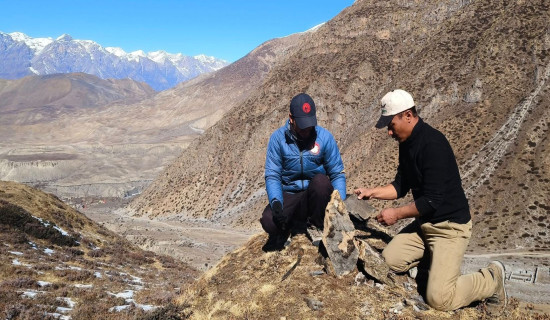- Sunday, 30 November 2025
A Collection Of Melodious Songs
In fact, lyrics are not only literature in singing form, but they can also be enjoyed in reading and opinion making, too. Just like quality poems draw huge numbers of readers, lyrics, too, share the same merit. So, to cherish these values, books of lyrics are being published and are read with interest in the print form of words.
One new book of this kind is here for review. The title of this under-reviewed publication is Lahari-Lahari (Waves-and-waves), and the author who composed it is senior lyricist Birendra Pathak.
In fact, Pathak’s interest and experience in lyric writing are deep and long. We can recall some of his notable songs, like the “Malai Yehi Jeevan Badhai,” sung by well-known singer Aruna Lama in the music of Ganesh Pariyar, and the “Sabaibata Tiraskrit Bhaye Tapani” by legends like Bhakta Raj Acharya in his own music.
This book’s epilogue also mentions the gratitude of lyricist Pathak for singers/musicians like Shakti Ballav, Bhupal Man Singh, Mana Raja Nakarmi, Sunil Maske, Jon Shahi, Sukmit Gurung, Murali Dhar, Rupak Dotel, Suraj Kumar Thapa, Nisha Deshar, Banika Pradhan, Melina Rai, Prabin Shahi, Dipak Raj Biswokarma, Ratna Shova Maharjan, and Suresh Lama.
The Lahari-Lahari altogether is a 137-page collection, but the number of lyrics in it is 133. This small physique and so many songs in it are the proof of artistic expression of sentiments and the precision rule of songwriting.
Here, we can connect even the book title words “Lahari-Lahari.” In fact, these two words themselves are so sweet and rhythmic and thus carry the significance of all the songs of the book. Lyricist Pathak himself admits to the fact that it is the mind, heart, and mood of the composer that become wavy-wavy (Lahari-Lahari) and bring sweet words, and it all becomes songs. This is the experience of lyricist Pathak in songwriting.
If we categorise 133 songs of this collection in terms of messages, we find the composer has given a beautiful expression to the genuine themes like true love, the definition of life, patriotism, themes of natural beauty, divinity, dreams of life, doubts and benefits of doubts in love, and the situation of difficulties that true lovers face.
In fact, the diversity of emotions is one of the prime beauties of songwriting. There are plenty of such themes and messages in this collection. However, amidst all these features, the veteran lyricist has also composed sweet devotional songs.
No doubt, love is the prominent theme. Let’s see what Pathak says with this theme:
Like the light of first sunrise,
Warmth touch filled heart
It is a time of blossoming love for me.
Page 10 in the book
In fact, the touch of love is so soft, it lifts the whole spirit silently and spontaneously; the lyricist’s words ‘blossoming love’ and ‘light of first sunrise’ are the supreme symbols of love here.
In another song, the lyricist Pathak even seeks enlightenment through the medium of pure love. Let’s take four lines in the literal English translation from Nepali:
Something greater than moonlight arrived today
No other light needed
Want to feel enlightenment in this light
So, let me go towards this path
Page 70 in the book
There are some polished lines also of patriotic expressions from the composer in this anthology:
We Nepali spread peace,
Extend light like sun and moon,
Don’t do injustice, don’t tolerate injustice
Don’t move back because we are brave.
Page 10 in the book
In other contexts, the lyricist tries his best to epitomise Nepal’s rare beauty in these words:
Let’s smile like mountain and dance like Danfe bird
Let’s live to become Nepali with love of Nepal
Page 16 in the book
In some songs in this collection, the composer’s spontaneity of expression even finds a single line that keeps strength to empower each song, laying emphasis beautifully on the key message.
Two such lines, one from the song entitled “Sukha-Dukhako” (of joy and pain) and the other from the piece “Hune Kura” (things bound to happen), can be presented here as an example:
Uttam Dhayana Sthir Pran, Uttam Dhyana Sthir Pran
(Meditation is best, meditation only is best for stable soul)
Samyam Huna Saknelai Je Bhayeni Chhudai Chhunna
(Nothing can disturb a patient person)
Page 32 in the book
Thus, we can say the under-reviewed “Lahari-Lahari” collection by senior lyricist Birendra Pathak is an asset to the lyric genre of Nepali literature. That is because it contains diverse themes and emotions of life. The merit of this collection lies even in the sweetness and simplicity of words and language. Readers can feel the set of tunes even in singing. But the real test of songs begins when they reach singers and musicians. We hope “Lahari-Lahari” songs attract artists and lyricist Birendra Pathak keeps writing such Nepali songs in the future also.
(Kafle is a former Deputy Executive Editor of this daily.)
















